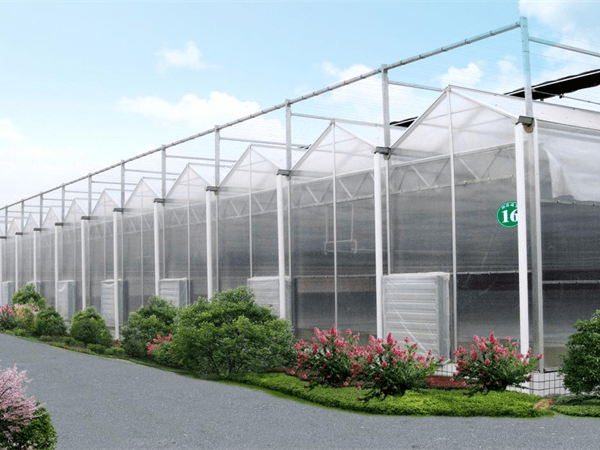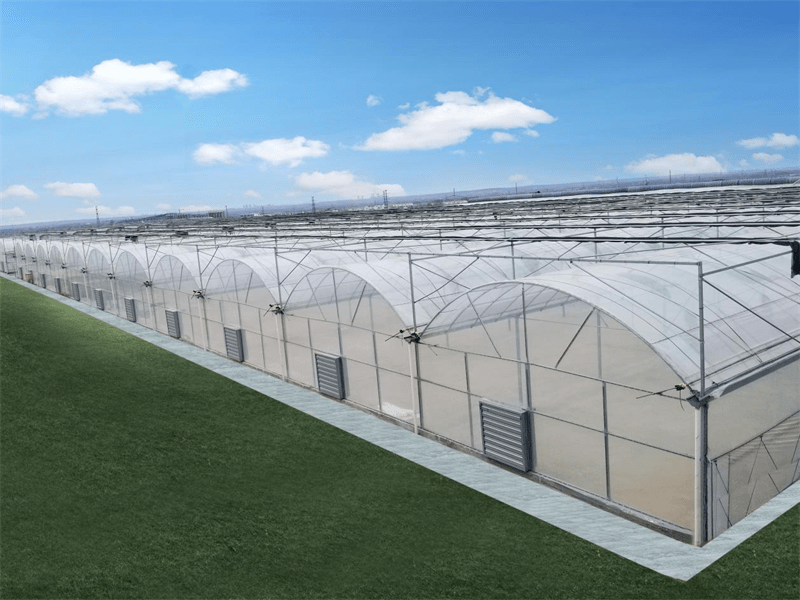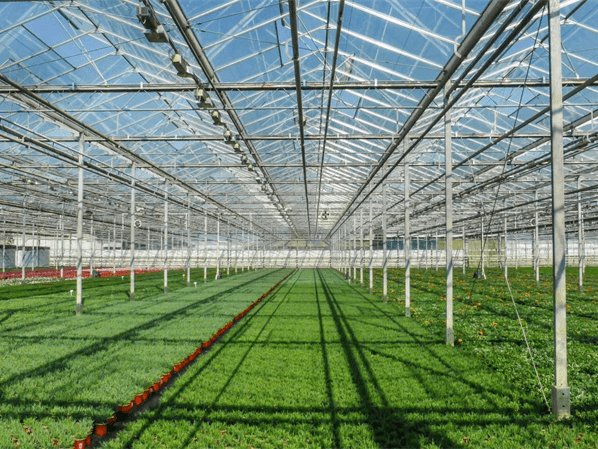Multi-Span Agricultural Glass Greenhouse
description2
Characteristics of Glass Greenhouse
Parameters
| Type | Multi-Span Glass Greenhouse |
| Span Width | 8m/9.6m/10.8m/12m |
| Bay width | 4m / 8m |
| Gutter hight | 3-8m |
| Snow load | 0.5KN/M2 |
| Wind load | 0.6KN/M2 |
| Hanging load | 15KG/M2 |
| Max rainfall discharge | 140 mm/h |

Greenhouse Cover&Structure
- 1. Steel Structure
- The steel structure is made of high-quality carbon steel that meets national standards and undergoes processing according to specific technical requirements. Inner and outer hot galvanized steel should comply with national standards for quality products, with the galvanized layer having uniform thickness, no burrs, and a minimum thickness of 60 microns.
- 2. Cover material
- Glass cover usually uses tempered glass panel on the roof, thickness 4mm, 5mm or 6mm, hollow glass panel on the sides, float glass or tempered glass, thickness 4+6+4mm or 5+6+5mm. The glass is fastened through special-use aluminum profiles.

Inner Sunshade&Warming System
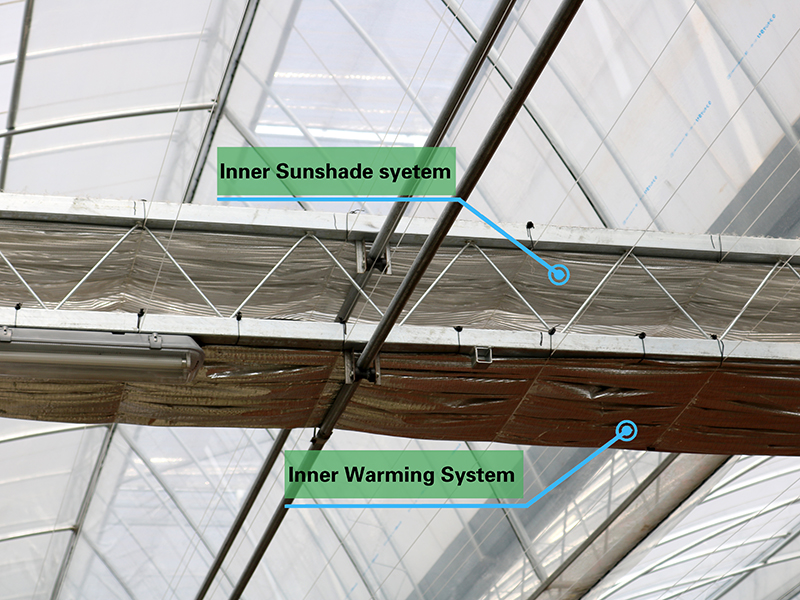
This system involves the installation of an inner sunshade net within the greenhouse structure. During the summer, its primary function is to lower the internal temperature. Conversely, during winter and at night, it serves to prevent the dissipation of heat. The system is available in two variations: ventilation type and thermal insulation type, offering flexibility in its applications.
An internal thermal insulation curtain system is primarily utilized in cold regions where temperatures drop below 5°C. During cold nights, this system effectively prevents the loss of heat through infrared radiation, reducing surface heat loss and, consequently, decreasing energy consumption for heating. As a result, it can lead to lower operating costs for greenhouses.
Cooling System
The cooling system uses the principle of water evaporation to reduce temperature. It comprises high-quality cooling pads and powerful fans. The core component of the cooling system is the evaporative cooling pads, which are made of corrugated fiber paper and have a long working life due to corrosion resistance and a special chemical composition in the raw material. The unique cooling pads ensure complete saturation with water, and as air passes through them, the exchange of water and air changes hot air into cool air, effectively humidifying and cooling the air.

Ventilation System

The greenhouse ventilation systems come in two types: natural ventilation and forced ventilation. In film greenhouses, natural ventilation is achieved using roll membrane ventilation on both the roof and sides, while in sawtooth greenhouses, the main method for roof ventilation is roll film ventilation. Insect-proof nets with a 60 mesh size are set up at the ventilation openings to keep insects out. Additionally, the ventilation systems can be tailored to match specific customer needs and growing conditions.
Heating System
There are two types of heating systems: one uses a boiler to produce heat, while the other relies on electricity. Boilers can be fuelled by coal, oil, gas, and biofuels. They require the installation of pipelines and a water warming blower for heating. If electricity is used, an electric warm air blower is needed for heating.

Light Compensating System

The greenhouse compensating light, also known as plant light, is an essential artificial light source that is supplied to plants for their growth and development, in place of natural sunlight. This is based on the natural law of plant growth and the principle that plants use sunlight for photosynthesis. Currently, the majority of farmers utilize high pressure sodium lamps and LED lamps to provide this necessary light for their plants.
Irrigation System
The greenhouse irrigation system includes: water purification system, water storage tank, irrigation system, and water and fertilizer integrated machine.We supply two types of irrigation system, drip irrigation system and spray irrigation system. So you can choose the best one for your greenhouse.
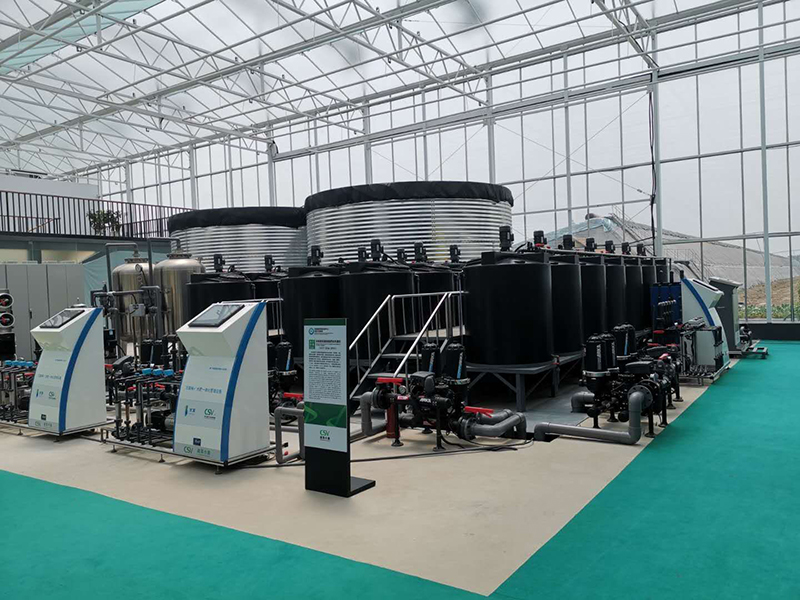
Nursery Bed System

The nursery bed consists of a fixed bed and a movable bed. The movable nursery bed has specific measurements: the seedbed has a standard height of 0.75m, with slight adjustability. Its standard width is 1.65m, which can be modified to suit the greenhouse's width, and the length can be customized as per the user's needs. The movable bed grid is 130mm x 30mm in size (length x width) and is constructed from hot dip galvanized material, ensuring high corrosion resistance, great load-bearing capacity, and a long service life. On the other hand, the fixed bed measures 16m in length, 1.4m in width, and has a height of 0.75m.
CO2 Control System
The primary goal is to monitor the CO2 levels in the greenhouse in real-time to ensure they remain within the optimal range for crop growth. This monitoring system consists primarily of a CO2 detector and a CO2 generator. The CO2 sensor is a crucial component used for measuring and detecting CO2 concentration. It allows for continuous real-time monitoring of the greenhouse's environmental conditions, providing the ability to make necessary adjustments based on the monitoring data to maintain an environment that is ideal for plant growth.

Control System

The greenhouse control system typically consists of a control cabinet, sensors, and circuits. This setup allows for semi-automatic control to be implemented. Additionally, computer-based networking can be used to intelligently manage the greenhouse systems.





